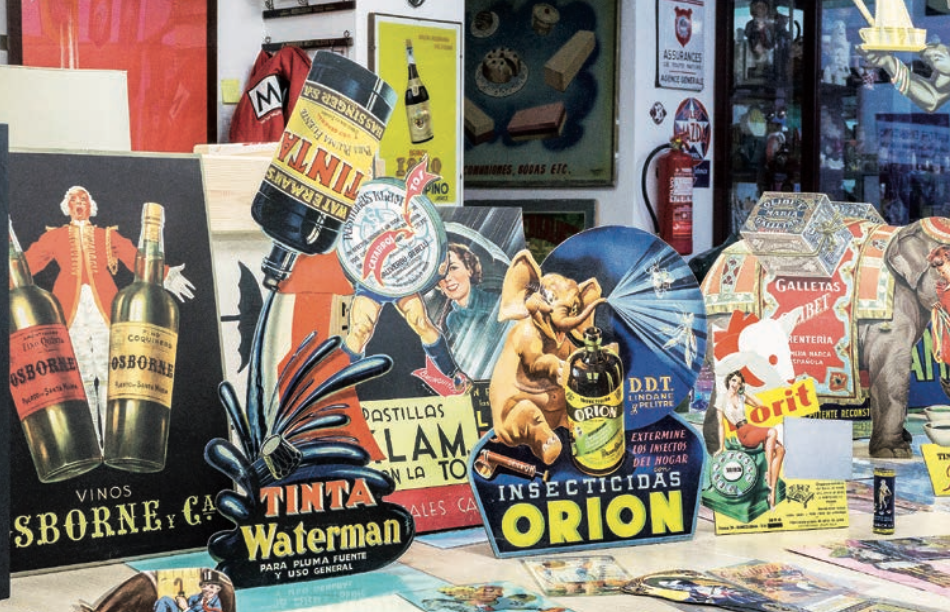reports
Marc Martí Collection. The passion for graphics as an art form
Marc Martí's collection, focused on posters, graphic arts and advertising, is unique in Catalonia for its originality and historical value

The art collection of businessman Marc Martí is one of the most unique currently in Catalonia due to the originality of its content. It is the most important collection of posters, graphic arts and advertising in the entire State, and it possibly does not have many competitors in the international arena for the richness and variety of its fund. Entering its archive museum is a feast for the eyes, although you can't see everything it contains. Located in the Poblenou district, right next to the offices of the company that bears its name, upon entering the walls covered with posters of different commercial brands, the display cases full of all kinds of objects and the numerous files that save everything that cannot be seen. And it would really be impossible to exhibit everything, not only for a matter of space, but also for conservation issues. In fact, 80% of what he owns is stored in filing cabinets. "Our enemies are light and moisture", says the creator of the fund.
Graphics memory
Immediately, our memory is put to work to remember when we saw some of the posters and advertisements that are displayed, taking us back to our own past. Signs of all kinds, enamel plates, containers, figurines, plates, etc. they create a sense of vacui horror that, seeing them in this context, makes us notice their aesthetic quality even though we might not pay attention to them on the street. In a way, it is a "museum" of memory, a sentimental "museum", although it can not only be seen that way. Economists, sociologists and historians, while visiting their funds, could extract material for academic work.
 Marc Martí en la presentació d’una exposició a València. Al fons, un cartell de Josep Renau.
Marc Martí en la presentació d’una exposició a València. Al fons, un cartell de Josep Renau.
Graphics as a work of art
In fact, with this fund Marc Martí has published important books in which he documents his objects in a very consistent way, such as the book dedicated to Josep Morell, one of our most important poster artists between the 1920s and 1940s. Others have been dedicated to the posters of the great Ramon Casas, to the graphic work of Alexandre de Riquer or to cava plates. These are publications that reassess the collection and show the collection and conservation work it does.
I've used the word museum several times, but it's not actually a museum in the most traditional sense. He does receive, on the other hand, many requests from local and international museums to leave them pieces from his collection. Marc Martí is a kind, self-made man who started collecting a little as an inheritance from his father's habit of collecting stamps and coins. Coming from a family of locksmiths, to start earning a living when he left high school, he went around the street pasting posters for concerts by Raimon, Pi de la Serra, Joan Isaac, among others, or concerts in the Palau de la Música Catalana or the Canet... In 1987 he opened, with his father and brother, the Art Cava Fusina champagne house, where he began to hold the first exhibitions, not only of posters but also of painters and illustrators Marc Martí understands graphics as a work of art. Many of the pieces he owns are bought in street markets, antique shops or charms: "Each one has a story", he tells me. His dealings with merchants in the bouquet help him stay informed to take advantage of opportunities that come his way. If he knows that a store is closing, he can save whatever suits his interest as a collector. For example, it keeps the neon lights that advertised the legendary Vinçon store on Passeig de Gràcia in good working order. "I don't have a car and I go with a van, which is what I like", he explains, which is a good indicator that he is always on the lookout to take advantage of any opportunity. We could say that it is a recovery task, but "you have to be alert".
The future of the collection
For Martí, collecting "is like a vice", an expression that coincides, by the way, with that used by many art collectors. But he remarks: "In my case, there is a discourse and there is also a purpose. We have made specialized books of what we have, but not only that but, for example, in the case of the book by Alexandre de Riquer or Ramon Casas, looking for the images of everything we have known or that we thought was congenial to do of the book a unit", and thus enrich its content. As favorite pieces, he mentions posters from the modernist era or those from the Civil War period, which "is another world", he confesses. Certainly, they are posters with very powerful graphics. He tells me that his idea for the future is to maintain the unity of the collection, and he tells me that he is preparing a small catalog of three volumes that collects what he has and that will serve him to reflect on the moment in which our society is living with the growing digitization, which paradoxically is often more of a source of misinformation or disinterest in delving deeper into something. "I'm anti-mobile and anti-computer", says Marc Martí emphatically, adding that nowadays many people don't know, for example, how to name a color or that, seeing pieces from his collection that are already a certain age old, they would be unable to say what they are or what they were used for. In short, a lack of the most basic visual culture.









